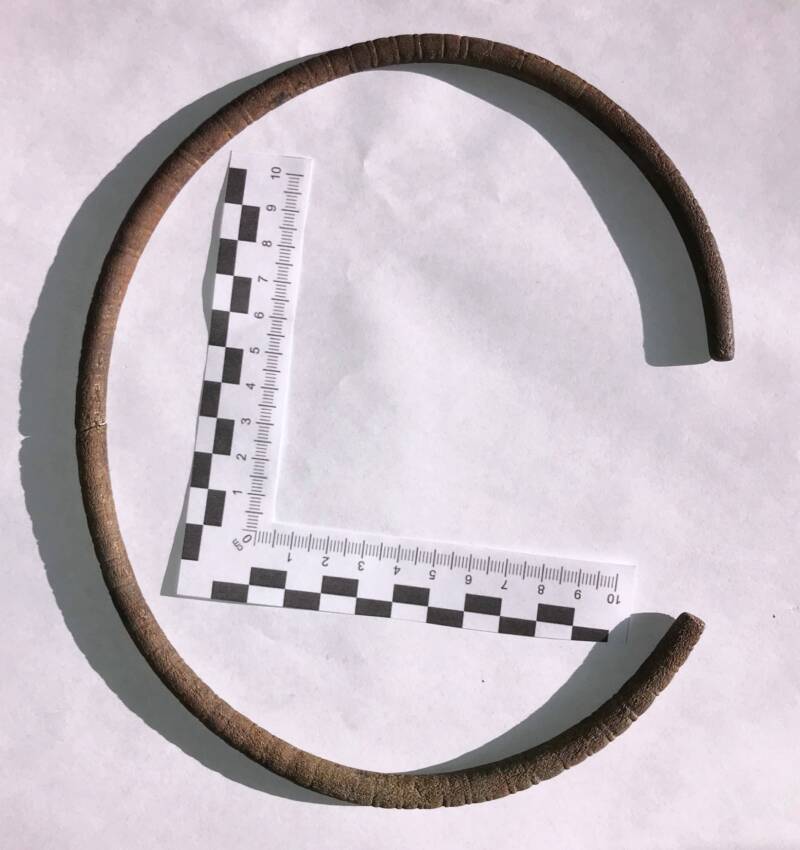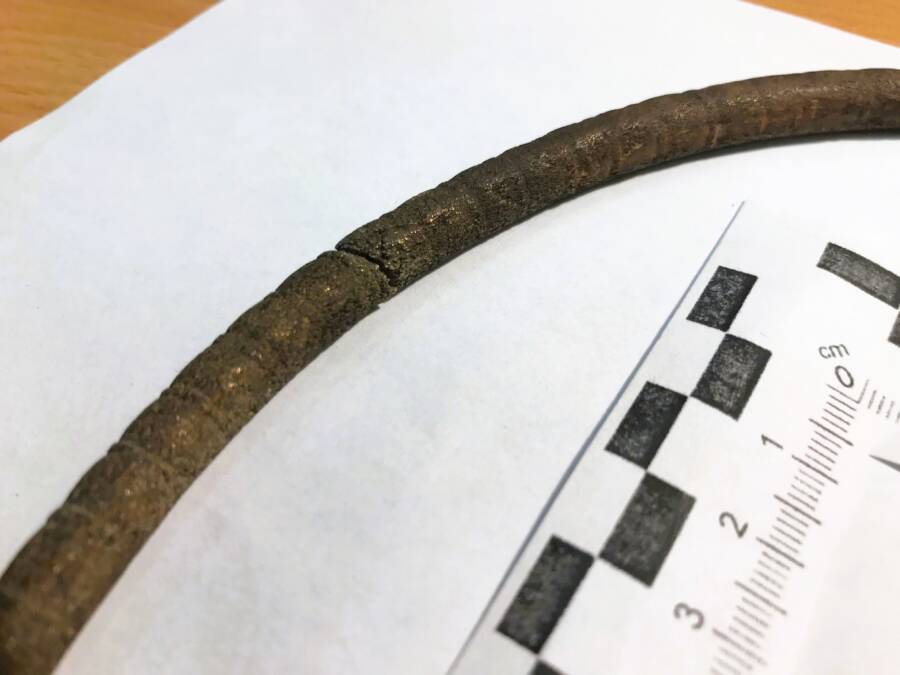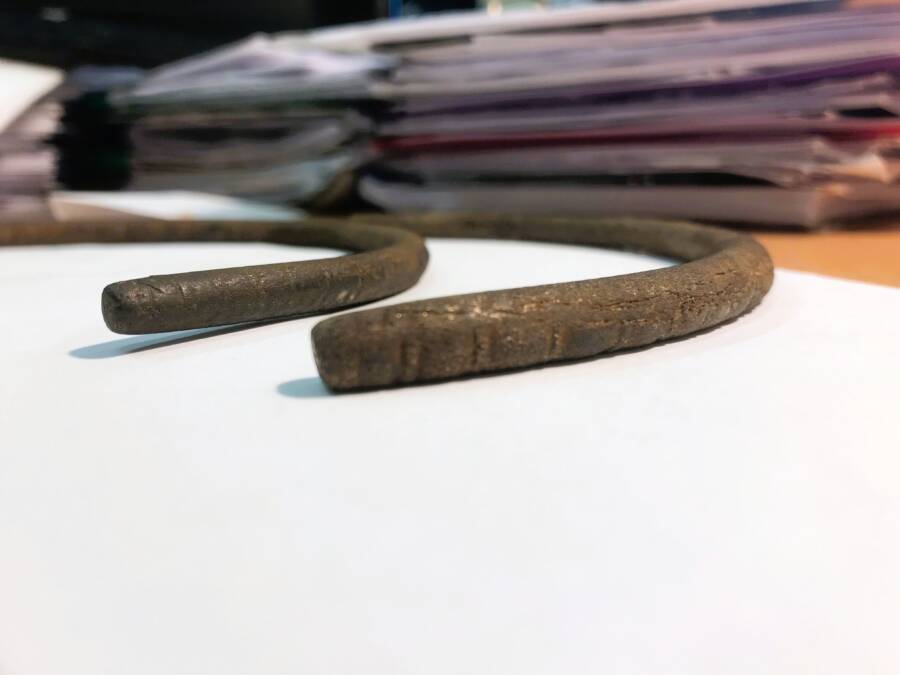Experts believe that the necklace is a relic of the Hallstatt culture, the dominant group in the archaeological record of western and central Europe throughout much of the Bronze Age and the Iron Age.

Provincial Office for Monument Protection in OlsztynThe necklace is 2,500 years old, dating to the Hallstatt C period.
In the small village of Bartosze, Poland, the son of a local farmer was clearing a pasture and trying to make it easier for the cattle to access a watering hole when he stumbled upon an ancient treasure, broken in half. The two cleanly split pieces quickly came together to form an open-ended necklace made of bronze and decorated with a double groove pattern on its exterior.
Realizing the importance of this discovery, the farmer then handed the artifact over to the local branch of the Provincial Office for the Protection of Monuments in Elk, which concluded that the necklace dated back a whopping 2,500 years. No other necklaces found in the region come from this era, an interesting period of history when the Bronze Age was transitioning into the Iron Age.
A 2,500-Year-Old Bronze Necklace Found In A Polish Farmer’s Field
According to the Polish Press Agency (PAP) Foundation, the farmer’s son found the necklace in January 2025 while working in his family’s field. At the time, the necklace was broken in two, but the pieces were split cleanly, allowing it to be pieced back together.

Provincial Office for Monument Protection in OlsztynA close-up of the groove patterns on the necklace.
After the necklace was handed over to local officials, it was analyzed and found to be made of bronze. It was crafted out of a single metal bar and decorated with a circular double-groove pattern. It was dated to around 2,500 years ago, during the late Bronze Age, a period also referred to as Hallstatt C.
“The necklace dated to this era has long been found by no one on our territory. We had a few axes coming from explorations and a few fasteners, but younger ones — from the Roman period,” said archaeologist Magdalena Kozicka.

Provincial Office for Monument Protection in OlsztynThe necklace was made from a single bronze bar, bent into a circular shape.
Based on the timeline, experts say the necklace may have been worn by someone in the Lusatian culture, or someone during the early days of the West Baltic Kurgan culture. The necklace came from a time of transition between the Bronze Age and the Iron Age, when the first iron swords started appearing among bronze ones.
The necklace is set to be further analyzed for its metalwork at the Institute of Archaeology at Nicolas Copernicus University in Torún before being transferred to one of the region’s museums.
Why The Hallstatt C Period Was A Transformative Time In Polish History
The Hallstatt C period occurred roughly between 800 and 600 B.C.E., a time of transition between the Bronze Age and the Iron Age. As its name would suggest, the period was associated with the Hallstatt culture, named for a prominent archaeological site in Hallstatt, Austria. During this period, the use of iron became more widespread and led to numerous advancements in tool and weapon manufacturing.
In Poland, this period also corresponded with the later phases of the Lusatian culture, which dominated much of the region during the Late Bronze and Early Iron Ages. The Lusatian culture was renowned for its well-developed settlement structures, fortified sites, and material wealth.
The earliest iron objects found in Polish territories, including decorative pins, axes, swords, and horse harness components, date back to the Hallstatt C period. These objects also highlight a shift in Lusatian culture, particularly in funerary practices, where both burials and cremations occurred. The presence of richly furnished wooden-chamber graves also suggests the development of social stratification and the rise of social elites during this time.
The Hallstatt C period also saw advancements in local industries, including the exploitation of salt in Kuyavia and zinc-lead ores in Upper Silesia.
Other recent studies have identified the use of meteoritic iron in artifacts from this era. Analysis of items from cemeteries in souther Poland, such as Częstochowa-Raków and Częstochowa-Mirów, revealed that some iron artifacts, including bracelets and pins, were crafted from meteoritic iron.

Albert Jambon et al.Various ancient artifacts found in Poland that were made with meteoritic iron.
The deliberate use of meteoritic iron suggests that ancient Polish metalworkers possessed sophisticated metallurgical skills, possibly mixing meteoritic iron with smelted iron to achieve specific aesthetic effects. These practices notably predated the development of patterned metals like Indian wootz steel and Damascus steel by nearly a millennium, but the presence of meteoritic artifacts among a wide variety of non-elite burials also implies that it wasn’t considered particularly prestigious at the time.
This discovery, along with the Bronze Age necklace, contribute to the ever-growing evidence that our ancient ancestors were far more technologically knowledgeable and advanced than previous assumptions might lead some to believe.
After learning about this artifact from ancient Poland, read about the time a Polish man found a Bronze Age axe head in his raspberry bush. Then, learn all about the various “vampire” graves found in Poland throughout the years.





